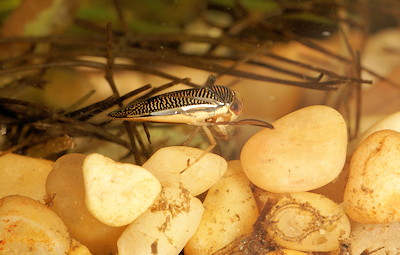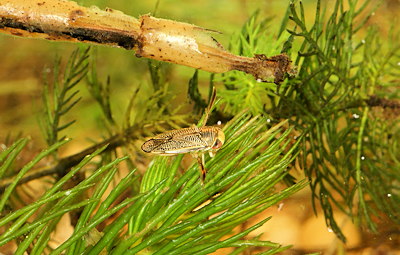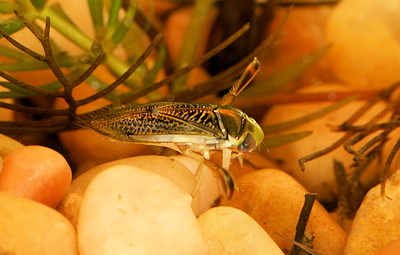 |
| Water Boatman |
Class: Insecta
Order: Hemiptera
Family: Corixidae
Since moving to Alberta in mid 2004 numerous fly fishers have informed me of their favorite waters. From these discussions one point was clear in my mind, water boatman had a strong loyal following. Fueled by images of clear autumn days, water boatman cascading into the water like rain drops as they undergo their annual mating and migration flights. Working water boatman patterns during these annual "falls" and again during the early spring ice off period are one of the numerous rewards available to stillwater fly fishers. Takes are seldom subtle.
Water boatmen are widespread and common inhabitants of lakes, ponds and slow moving stretches of rivers and streams throughout North America. In the fall of 2004 during a drift between Policeman’s and McKinnon’s Flats I was fortunate to dupe 20 plus inch rainbows on a simple water boatman pattern dangled below a parachute hopper, a new variation of sorts to the hopper dropper technique.
Water boatman are often confused with their larger predacious backswimmer cousins and anglers often intertwine names when referring to either family. With over 525 species worldwide and over130 species in North America alone odds are fly fishers and foraging trout run into boatman more often than backswimmers.
Size is one of the distinguishing factors separating water boatman from their larger backswimmer cousins. Although prolific, water boatman are not the largest of insects. Ranging in size from 6 to 12 mm (1/4"-1/2") boatman patterns are best dressed on hook sizes 12 through 16. During early spring and fall when boatman are at their largest try size 12 patterns. In the summer months when immature boatman predominate smaller size 16 hooks work best. Use light wire hooks for buoyant patterns and heavy or standard wire hooks for weighted designs.
 Viewed from above or below water boatman are elliptical in profile, their heads blending into abdomen providing an efficient hydro dynamic form. Upon reaching maturity the darkened back of the boatman houses a set of wings water boatman enabling them to take flight to mate and migrate. Located on the sides of the head is a pair of prominent eyes, worthy of imitation in larger sizes. The lower front of the head is home to the sucking beak-like rostrum water boatman use to dine on their primarily vegetarian diet. Omnivorous, water boatman also add a little meat to their diets at times such as chironomid larvae and other small fare. A balanced diet is critical to proper development. The elongated, feathered rear legs are the boatman’s signature feature and their primary form of propulsion as they scoot about in a quick jerky manner. The hind legs also help diffuse oxygen and supplement the air bubble boatman trap along their body to survive beneath the surface. Use Super Stretch Floss, Sili Legs, rubber hackle, goose biots or peacock herl strands to suggest this key feature. A strong pair of central legs set grasp onto vegetation and bottom debris as the boatman forage or rest so that the inherent buoyancy of their air bubble doesn’t drag them to the surface. The short forelegs are designed for scooping and sifting through the bottom detritus and serve as a communication vehicle. Boatman rub their forelegs against their heads and antennae to separate species, warn competitors and attract potential suitors.
Viewed from above or below water boatman are elliptical in profile, their heads blending into abdomen providing an efficient hydro dynamic form. Upon reaching maturity the darkened back of the boatman houses a set of wings water boatman enabling them to take flight to mate and migrate. Located on the sides of the head is a pair of prominent eyes, worthy of imitation in larger sizes. The lower front of the head is home to the sucking beak-like rostrum water boatman use to dine on their primarily vegetarian diet. Omnivorous, water boatman also add a little meat to their diets at times such as chironomid larvae and other small fare. A balanced diet is critical to proper development. The elongated, feathered rear legs are the boatman’s signature feature and their primary form of propulsion as they scoot about in a quick jerky manner. The hind legs also help diffuse oxygen and supplement the air bubble boatman trap along their body to survive beneath the surface. Use Super Stretch Floss, Sili Legs, rubber hackle, goose biots or peacock herl strands to suggest this key feature. A strong pair of central legs set grasp onto vegetation and bottom debris as the boatman forage or rest so that the inherent buoyancy of their air bubble doesn’t drag them to the surface. The short forelegs are designed for scooping and sifting through the bottom detritus and serve as a communication vehicle. Boatman rub their forelegs against their heads and antennae to separate species, warn competitors and attract potential suitors.
Besides size, color is one of the best boatman and backswimmers separators. At maturity water boatman feature dark backs with an almost copper hue and light tan to olive bellies. On some species the belly coloration is best described as the color of masking tape. Backswimmers on the other hand have light backs and dark bellies. Immature water boatman lean toward light yellow or olive tones with dorsal markings from their developing wing covers. Successful boatman patterns feature mottled shellbacks of pheasant tail, mottled turkey quills, Midge Flex or sheet foam complimented through artistic use of permanent markers.
Unique to the aquatic environment water boatman are air breathing insects capable of inhabiting a wide scope of environments other aquatic insects find toxic. Surviving beneath the surface through a process called aeropneustic respiration water boatman use minute hairs to trap a bubble of air along their bodies called a plastron. Oxygen is transferred directly from the air bubble through a series of tiny holes or spiracles. The shiny air bubble is a key feature providing an attractive trigger to foraging trout, often masking the boatman’s true colors. Reflective Mylar, Crystal Chenille, Super Weave Mylar, glass or metal beads and Diamond Dubbing should be key components to suggest the pearl silver sheen of the air bubble. This reliance on air dictates constant trips to and from the surface for replenishment, a hazardous trek exposing water boatman to predation limiting them for the most part to water 10 feet or less.
 Water boatman have a one year life cycle. Hatching from eggs typically laid in the early spring immature boatman inhabit the near shore shallows and wed beds. When entering the water clouds of them can be seen scattering before the observant fly fisher’s eyes. Growing through a series of 5 molts or instars water boatman are incapable of flight until their last instar occurring from late August through early October. At this time water boatman take flight to mate and disperse to new waters, returning boatman plunge headlong into the surface, whirling almost half stunned to break through the surface film and scoot to the bottom. Trout become attuned to this trait ravaging the boatman as they enter the water and during their subsurface jaunts. Beadhead or patterns tied in a weight forward manner are perfect for duplicating the naturals head first dive to the bottom. Crisp, bright, fall days after the first cold snap seem to trigger the greatest boatman activity, soon after ice off warm days can also trigger boatman flights. In the late fall and early spring boatman are most available and attain their largest size. During the warmer months water boatman are at their smallest and are of lesser importance. There are times when trout to forage in the shallows and an immature boatman pattern can be the key to the puzzle. It is not unusual for trout to focus upon a single aspect of boatman activity dictating increased angler observance and presentation skills. For example, buoyant foam based boatman patterns are popular when trout frequent the shallows or focus upon surface activity during annual mating and migration flights.
Water boatman have a one year life cycle. Hatching from eggs typically laid in the early spring immature boatman inhabit the near shore shallows and wed beds. When entering the water clouds of them can be seen scattering before the observant fly fisher’s eyes. Growing through a series of 5 molts or instars water boatman are incapable of flight until their last instar occurring from late August through early October. At this time water boatman take flight to mate and disperse to new waters, returning boatman plunge headlong into the surface, whirling almost half stunned to break through the surface film and scoot to the bottom. Trout become attuned to this trait ravaging the boatman as they enter the water and during their subsurface jaunts. Beadhead or patterns tied in a weight forward manner are perfect for duplicating the naturals head first dive to the bottom. Crisp, bright, fall days after the first cold snap seem to trigger the greatest boatman activity, soon after ice off warm days can also trigger boatman flights. In the late fall and early spring boatman are most available and attain their largest size. During the warmer months water boatman are at their smallest and are of lesser importance. There are times when trout to forage in the shallows and an immature boatman pattern can be the key to the puzzle. It is not unusual for trout to focus upon a single aspect of boatman activity dictating increased angler observance and presentation skills. For example, buoyant foam based boatman patterns are popular when trout frequent the shallows or focus upon surface activity during annual mating and migration flights.
Fly fishers have a full range of fly lines when fishing water boatman patterns, from floating to fast sinking. The floating line affords the greatest versatility. Use long leaders from 12-18 feet depending upon water depth and weighted patterns. Casting to boiling trout is exciting. Plop the pattern near the rise allowing the pattern to sink. Begin an erratic 3 to 4 inch strip retrieve suggesting the darting boatman. If regulations permit try multiple patterns of contrasting color or size to cover the bases. In or around weeds try a strike indicator, use 6 to 12 inch strips to rise and fall the pattern. Floating lines and small patterns are ideal during the summer months should trout venture into the shallows to snack on immature boatman. During the late fall when trout are well tuned into the annual boatman bonanza casting foam bodied patterns into the ring of the rise can be outstanding. I recall fond memories dropping patterns in front of prowling trout well into the evening.
Full sinking lines ranging from slow sinking intermediates down to fast sinking type 3 or greater densities are another option, even in shallow waters. With the explosion of foam based patterns the sinking line can be used to drag the fly down to the bottom and then stripped back toward the surface simulating the U-shaped path the naturals take to and from the surface. Anglers should take advantage of traditional sinking lines that sink with a belly first profile. Leader length can vary but using a leader of approximately the same length as the water is deep is ideal. Dart and strip the fly down. Begin by stripping the erratically and then change things up by incorporating a smooth slow strip retrieve suggesting the boatman’s ascent to the surface. Continue this alternating retrieve until it is time to recast or a trout latches on. Boatmen use the trapped air bubble to assist their ascent for a breather.
No matter the presentation technique vibrating the rod during the retrieve adds additional attraction animating the legs of the fly. Non Slip Loop or Duncan Loop knots provide additional swagger to the fly as it is free to swing during the retrieve.



